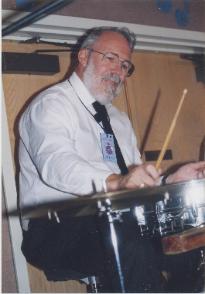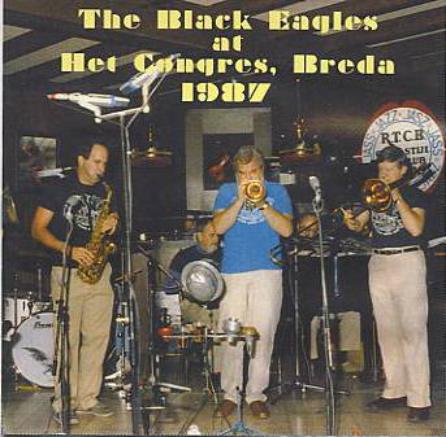by Bert Thompson
NEW BLACK EAGLE JAZZ BAND—AT HET CONGRES, BREDA, 1987 (OWN
LABEL: BE[LECD]4009). Playing time: 68m. 30s.
Bugle Boy March; Roamin’; She’s Cryin’ for Me; Chimes Blues; Rockin’ in Rhythm;
Joe Avery’s Piece; Mazie; Oh My Babe Blues; Stevedore Stomp; Red Wing.
Recorded at Het Congres, Breda, The Netherlands, on November 1, 1987.
Personnel: Tony Pringle, cornet; Bill Novick, clarinet, alto sax; Stan Vincent, trombone;
Peter Bullis, banjo; Bob Pilsbury, piano; “Pam” Pameijer, drums; Eli Newberger, tuba.
This is the ninth in a series of fourteen limited edition CD’s, reissuing material by the
band that previously appeared on LP’s—mainly on their own label but also on a few
other small labels, such as Philo, Philips, and Dirty Shame—and on cassette tapes.
Some of these cassettes were issued simultaneously with the LP’s but also contained
additional tracks. Other cassettes with different material were issued in that format
Almost any New Black Eagles recording gives a good representation of the band, and
this one, previously unreleased, is no exception. Like many others, it would provide a
good introduction to the group if one were needed. All of the New Black Eagles
features are here, beginning with the tune list. While there are only ten tunes on it,
each is given all of the space needed for the musicians to explore it, the shortest
selection being Kerry Mills’ Red Wing at approximately four and a half minutes, and
the longest Oh My Babe Blues coming in at a little over nine minutes. Other than
Chimes Blues and possibly Joe Avery’s Piece, perhaps, most of the others are not to be
found in many bands’ books. They include the two rather difficult Ellington pieces
Rockin’ in Rhythm and Stevedore Stomp, as well as the fairly obscure tune Roamin’.
While the band tends to emphasize ensemble work, some solos are provided in almost
each tune, often being backed by others in addition to the rhythm section. Thankfully
no track follows the tired formula of ensemble-solos-ensemble. In addition, one of the
features that I find enormously interesting is the textural variety achieved in some of
these solos. In Chimes Blues we have the cornet solo backed by banjo only, all the
others dropping out. That is followed later by the tuba solo being backed by stop time
from the piano, banjo, and drums. Or in Oh My Babe Blues we find the tuba being
backed by piano and, in the background—very faintly if one listens closely—
trombone, for two choruses. After the trombone solo (backed by the rhythm section) is
a cornet solo backed by piano, banjo, and, softly, drums, followed by clarinet backed
by banjo only. Succeeding that is a true piano solo, the rest of the band dropping out
completely, replete with broken time, block chording in places, single note
expressions in others—all reminiscent of Jelly Roll Morton. All of this variety
heightens the interest of the rendition to the degree that one is quite unaware of the
tune’s nine and quarter minutes’ duration.
Another characteristic of the band’s performance is what, for want of a better term,
might be termed exuberance. This is displayed not only in the lusty playing of each
musician but also in their constant encouragement of each other, particularly when
one is soloing. The soloist is given the complete attention of the others in the band—
no chatting to each other or fiddling with instruments, etc.—and oftentimes the others
will emit encouraging cries and comments, during and especially at the end of a solo.
Such attention fosters the same focus by the audience itself—in effect it becomes a
“participant,” not just background. That, in turn, drives the band to even greater
heights, each feeding off the other.
So from the authoritative statement of the opening notes of the first tune, Bugle Boy
March, to the closing naming of the players of the last, Red Wing, this CD should have
the listener’s foot tapping.
According to the band, ordering information is as follows:
The 14 CD’s are a set only in that they represent 14 reissues of LPs and Cassettes from
the earlier days of the Black Eagles. We have not priced them as a set and have
typically sold them as individual items. You can find them by going to -
http://www.blackeagles.com/x.fullsite/cgi-bin/online-orderform.asp
To the right of the window you will see four lists - aisle 1, 2, 3 and 4. Click on aisle 2
and you will have an order form listing all 14 of the CDs.
|
|



